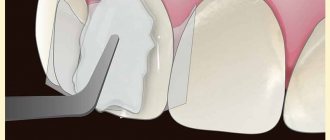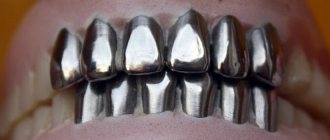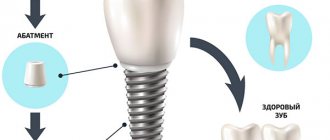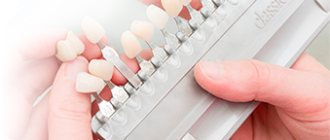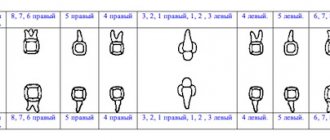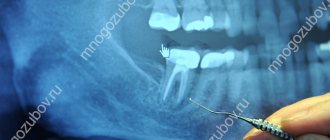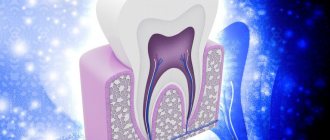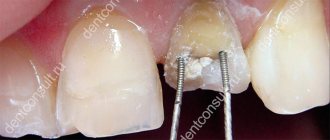- Indications
- Contraindications
- Alloys
- Kinds
- Advantages and disadvantages
- Stages of treatment
- Care
- Alternative Methods
- Advantages of the ROOTT Clinic
- Prices
- Work examples
- Doctors
- Reviews
- When to use:
any group of teeth - Material:
KHS, gold, titanium - Installation time:
7 to 14 days - Features:
high strength, durability, possibility of cladding - Service life:
up to 25 years - Type of anesthesia:
local
Cast crowns are prosthetic structures for replacing the supragingival part of a tooth, made by precision casting in a mold. They are used to compensate for single defects in the dentition, as part of bridges. Made from metal alloys, including precious ones. Thanks to the one-stage casting technique, the anatomical shape of the tooth and occlusal contacts are accurately recreated, which ensures a tight fit to the dental tissues without the formation of retention points (places where food accumulates).
Solid dental crowns are not aesthetically pleasing enough, so they are used for prosthetics of chewing teeth. During its existence, cast orthopedic systems have been regularly improved. These are strong, reliable, durable structures. A front lining made of ceramic or plastic material gives cast metal dentures a natural appearance, allowing them to be installed on the front teeth.
Contraindications
Relative
the procedure can be carried out with extreme caution
- Complex combined malocclusions;
- increased abrasion of the enamel of the antagonist tooth;
- inflammatory processes in the mouth;
- increased sensitivity of teeth;
- pregnancy;
- allergy to anesthetics;
- acute infections;
- period after radiation therapy, stroke, heart attack;
- mental disorders;
- exacerbation of a chronic disease.
Absolute
the procedure is strictly prohibited
- Teeth with living pulp in children and adolescents;
- severe periodontitis;
- oncological processes in the oral cavity;
- allergy to prosthesis material;
- decompensated diabetes mellitus.
What metal alloys are used
The designs have several options. Cast crowns are made from metal alloys with high strength:
- Chromium-cobalt alloys (CHS)
are high-alloy steels, characterized by density, elasticity, good fluidity (in the molten state), and high resistance to oxidation and corrosion.
The mechanical viscosity of CHS is higher than that of gold alloys. A prosthesis made from casting material based on chromium with the addition of cobalt and nickel is able to withstand high mechanical loads without deformation or destruction. The service life of such structures is 12-15 years
, and the price is the most affordable. The main disadvantages are poor aesthetics and the risk of developing allergies. - Gold-based alloys
are characterized by high strength and corrosion resistance.
The high plasticity of the material allows you to create dentures that fit exactly to the dental tissues and gums. Gold solid-cast tooth crowns have properties identical to natural enamel and do not damage opposing units. They have an antibacterial effect, are biocompatible with body tissues, and do not cause allergies or rejection. To give the material sufficient strength, gold is combined with palladium, platinum, copper, and silver. Service life - 20-25 years
. Cons: poor aesthetics, high price. - Titanium alloys
– the strength of titanium prostheses is 9-10 times higher than that of structures made from other materials. Biocompatible, inert to chemical and temperature influences, the material does not have a destructive effect on antagonist teeth. Prostheses made of titanium alloys are lightweight, have precise marginal and internal fit, and are used to compensate for single defects as part of long-distance bridges. Disadvantages - titanium is difficult to process and has low adhesion to ceramics, which increases the risk of chipping the outer coating.
The crown material is selected according to the clinical picture. The doctor takes into account the specifics of the situation, offers several effective options, among which the patient chooses the optimal one in terms of price, aesthetics, and functional properties. Metal-ceramic structures are more aesthetically pleasing than all-metal or metal-plastic crowns. Plastic cladding quickly absorbs foreign odors and coloring pigments, and changes color within a few months. It is not able to withstand a full chewing load and begins to crack and chip.
Types of cast crowns
Cast crowns are divided into:
- all-metal
– dental caps made of shiny polished metal. They are characterized by poor aesthetics and are absolutely not similar to a natural tooth; - with sputtering
– the prosthetic structure is coated with a composition that imitates precious material (“gold-like”) using vacuum-plasma equipment. Externally, such structures look more aesthetically pleasing than all-metal ones, but the golden plating does not in any way resemble natural enamel, and moreover, it increases the risk of an allergic reaction; - with veneering
(partial, full) – partial veneering involves installing a ceramic or plastic overlay on the front part of the crown. With full cladding, the metal structure is covered with a layer of plastic or ceramic mass to give a natural look.
Orthopedic systems fully lined with ceramics cannot be called a construction made entirely of metal. These are metal-ceramic crowns with good aesthetics and high strength, which can be installed in any part of the dental arch. The negative qualities of such structures are wear, chips of the ceramic veneer, and the appearance of a dark stripe in the gingival zone (around the neck of the crown) due to oxidation of the metal frame.
Is it possible to remove a metal crown?
Sometimes during operation it may be necessary to remove the metal crown. This is required in cases where:
- the crown decemented, as a result of which it became mobile;
- the tooth under the crown began to hurt due to the development of caries;
- there was a need for prosthetic replacement of the adjacent tooth. In this case, it is easier to install a bridge that will solve the problems of several damaged teeth at once;
- The crown is worn out and requires replacement.
To remove a metal crown from a tooth, dentistry uses two main methods: sawing and using a Kopp apparatus.
| Sawing | Using a Kopp apparatus |
| A specialist uses a drill to separate the structure without touching the tooth underneath. The downside of the procedure is that the patient will again incur the cost of a new metal crown. However, in cases where there is already a chip or crack, this is the best option. | The tooth is subjected to ultrasound to reduce the strength of the dental cement that holds the crown in place. Then a device is put on top of it, which helps remove the structure without causing harm to the tooth. With this method, the crown usually remains intact. |
If the crown is removed due to the development of caries, then it is first treated, and only after that a microprosthesis is installed. If it falls off the patient during use, then the doctor will conduct an examination and find out why this happened. After the cause is found and eliminated, the metal crown will be put back.
To avoid having to resort to repeated prosthetics with metal dental crowns, you should take a responsible approach to choosing a specialist and, of course, monitor your oral health - both at home and under regular supervision of professionals.
Advantages and disadvantages
Advantages
- High precision fit to dental tissues due to the correct anatomical shape;
- crown thickness is 0.3-0.5 mm, which avoids deep tooth preparation;
- durability – service life is 15-25 years;
- the possibility of spraying and cladding to improve the aesthetics of the structure;
- recreating the correct occlusion and chewing surface of the teeth;
- affordable price for manufacturing and installation.
Flaws
- Increased abrasion of the enamel of antagonist teeth;
- the need for turning;
- high thermal conductivity (due to the proximity of the pulp, discomfort and pain may occur);
- risk of allergies (except for structures made of precious metals);
- low aesthetics (excluding metal ceramics).
Advantages and disadvantages
Advantages
- Manufacturing a stamped metal crown takes 1-2 days;
- can be installed on “living teeth”;
- minimal trimming of hard tissues;
- low price.
Flaws
- Low aesthetics even for lined structures;
- insufficient adherence to dental tissues, formation of retention zones (places where food accumulates);
- risk of allergies, galvanism;
- combined structures are subject to delamination of materials, are fragile, and are not suitable as a support for a bridge or orthodontic system;
- plastic stamped crowns absorb foreign odors, food coloring, quickly lose color, crack, chip;
- short service life - 2-3 years;
- the appearance of a bluish stripe around the prosthesis due to metal oxidation (gray neck);
- quick erasing, changing the shape of the chewing surface;
- do not restore the exact anatomical shape of the tooth.
The advantages of stamped crowns are few. There are 2 main advantages: price and ease of manufacture. The designs have significantly more disadvantages. Stamping does not make it possible to produce an anatomically accurate orthopedic system, which is why the product does not fit tightly enough. There remains a gap between the gum and the metal, where bacterial plaque and food debris begin to accumulate. This leads to inflammation of the gums and progression of caries.
Manufacturing and installation
Dental prosthetics with cast crowns includes clinical and laboratory stages.
Clinical
- Diagnostics
– examination, making a diagnosis, drawing up a treatment plan, choosing a prosthetic system. - Preparation
- preparing the tooth for a cast crown (giving the desired shape to the stump) taking into account safety zones, taking impressions using an impression tray and plastic base masses, determining the central occlusion, fixing a provisional (temporary) crown on the stump to protect dental tissues. In case of severe destruction of the supragingival part (when only the root remains), a stump inlay is used as a platform for fixing the prosthetic structure. - Installation
– checking the quality of the finished prosthesis (fitting) in the oral cavity, fixation with dental cement.
Laboratory
Laboratory steps for making cast crowns include:
- Modeling
- creating combined collapsible models from plaster, making a wax model. By gradually layering wax, the workpiece is given an exact anatomical shape - the equator, the contours of the chewing tubercles or the line of the cutting edge are recreated; - casting of crowns
- a metal alloy is poured into a casting mold made from a wax model, cooled, and the solid structure is released from the mold. At the request of the patient, the prosthesis is covered with ceramic lining or spraying. The design is fitted on a working (plaster) copy of the patient’s tooth and, if necessary, adjusted; - grinding, polishing
- process the surface of the finished crown using special brushes, wheels, polishing pastes to give smoothness and shine.
The steps involved in making cast crowns represent a standard dental procedure. Sometimes the denture is first fixed with a temporary composition to find out whether there is an allergy to the material and how comfortable the design is when wearing and chewing. If there are no negative factors, the crown is secured with durable medical cement.
Installation of a metal crown
Before the procedure for installing a metal crown, the patient will first undergo a diagnosis of the condition of the oral cavity, professional teeth cleaning, caries treatment and canal filling, if necessary. Only after this can you begin to fix the metal crown on the tooth. The installation of all structures takes place in several stages:
- The damaged tooth is ground down or, if the crown is destroyed almost to the base, a special inlay is installed on it, onto which the structure is then fixed.
- An impression of the tooth under the crown is taken, as well as the teeth adjacent to it.
- A temporary onlay is placed on the tooth; it will protect it from destruction while the permanent structure is being manufactured.
- A three-dimensional model is made from wax, and a permanent crown is cast on it.
- The temporary structure is removed and a permanent metal crown is installed on the tooth.
To install a metal crown on a tooth, the patient, as a rule, needs to come to the dental clinic twice: to prepare for prosthetics and only then to fix the microprosthesis.
Alternative Methods
Zirconium Durable crowns with high aesthetics, suitable for anterior and posterior teeth
Ceramic Esthetic crowns for single restorations and dental bridges (up to 3 units)
Metal-ceramic Inexpensive, durable crowns are chosen for premolars, molars and dental bridges (up to 4-5 units)
Article Expert
Meliksetyan Daniel Oganesovich Dentist-orthopedist, doctor of the highest category
Work experience: more than 17 years
Prices
Free online consultation with a dentist
| Service | Price |
| Installation of a metal-ceramic crown (Germany Ivoclar, cobalt-chrome) | from 15,000 rub. |
| Installation of a metal-ceramic crown based on a bio-alloy - gold (Ivoclar Germany + cost of material according to the certificate) | from 25,000 rub. |
Consultation and diagnostics are free!
All prices Promotions
Sign up for a consultation
three ROOTT specialists + diagnostics as a gift
Cost and care of solid crowns
| Name | Price from |
| Consultation with an orthodontist (included in the manufacturing cost when ordering a crown) | 500 rub. |
You need to care for dentures in the same way as natural teeth. You should clean them regularly, rinse your mouth after every meal, and try to keep food particles away from the junction between the crown and the tooth.
Denta Labor dental laboratory provides services for the production of solid crowns . You can find out more information about the cost and production time of this type of fixed prosthesis by calling +7 (495) 162-08-25 . We offer the most affordable prices that will be affordable to anyone with average income. Our clinic employs the best specialists who understand all the intricacies of their business. We will help you restore all the functions of your teeth!
